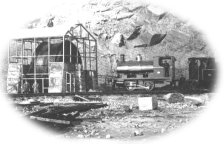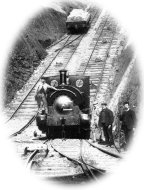Bole Hill QuarryBy Alan Jacques, © Copyright 1999Many visitors to the Peak do not realise that much of the landscape in they come to enjoy and experience in a variety of outdoor pursuits has been man made, as a result of the traditional local industry of quarrying. Millstones have been produced since at least the thirteenth century, there were scores of small independent operators and the owners of large estates like Chatsworth and Haddon owned large quarries specifically to provide building stone for their grand houses and estate villages. The eastern edges of Millstone, Burbage and Stanage were all extensively quarried. Other important sites were at Fallinge Edge near Rowsley, Cracken Edge above Chinley and the outcrops around Stanton in Peak and Birchover. Grindleford and Stoke were also renowned for their quarries that produced exceptionally good quality gritstone. In addition to the well-known Stoke Hall Quarry, which is still very active today, the village was almost surrounded by quarrying activities. At various times there were working quarries at Oak's Wood, Tedgness, Tumbling Hill, Pinnacle Quarry, Yarncliffe, Fallcliffe (2 sites), White Edge, Mag Clough, Riley off Eyam New Road, Sandy Lane, Gill's Quarry between Hathersage Road and Sir William Hill Road and the Parish Quarry on Sandy Lane - known now as the Parish Piece. The one area which in its day was a "super-quarry" to rival that of any current working site, was Bole Hill Quarry, at Upper Padley above Grindleford Station. Work here prompted mini-boom in the population, as a small temporary "shanty town" was built to house workers and their families. Some members of this community stayed on to live and work permanently in Grindleford and there are descendants from some families still in the village. When the Derwent Valley Water Act of 1901 was passed to construct the Howden and Derwent Dams, the question arose of where the stone for them was to come from. Initial plans to quarry stone in Ladybower Clough had to be dropped when objectors called a public meeting in Sheffield Town Hall that forced the Derwent Valley Water Board, whose successors are now Severn Trent Water, to find a more acceptable source. It appears that pressure groups are nothing new! As masonry rather than earth dams were to be built, a reliable source of good quality stone in quantity was required. In November 1901 the Board purchased 52 acres of land at Bole Hill from Mr Shuttleworth of Hathersage, and compensation of £20 was paid to Mr Cooper, a tenant of part of the land. The area was already quarried, chiefly for millstones, piles of them can be seen on the northern edge of the old workings, where they had been abandoned when the industry collapsed due to cheaper foreign imports, forcing a disastrous slump in trade. The beds of stone were near to the surface at an average depth of some 65 feet. The quarry face was 1,200 yards long and it was estimated that it contained some 2.4 million tons of top grade building stone. The silica and feldspar composition of the millstone grit at Bole Hill had the advantage of hardening after weathering. So much so that the masons found some of the stone that had already been exposed to the atmosphere was exceedingly hard and more laborious to work than the freshly quarried stone. It was the perfect material from which to construct the Howden and Derwent Dams. Steam traction engines brought in the heavy plant and equipment from the Sheffield Road at the Surprise to lay a standard gauge railway in the quarry face, which was then linked by an incline to the Midland Railway Hope Valley Line, almost 400 feet lower down the valley (see photograph 2). Water was provided from the Burbage Brook in Padley Gorge by means of a ram-pump that lifted some 16,000 gallons per day a height of 370 feet into storage tanks holding 35,000 gallons. Special early morning trains were laid on to bring workers in from Sheffield. Accommodation was also provided adjacent to the site in tin bungalows, similar to those for the construction workers of the dams at Birchinlee, in the Upper Derwent Valley. The plateaux where these huts were sited can still be seen, on the slope behind Padley Chapel to the east of the incline. Facilities were basic, but included a library and recreation room in addition to mess rooms. Vestiges of how the huts looked can be seen at Padley Chapel Bungalow (please respect the occupiers privacy). During its seven and a half years life the quarry produced over 1.25 million tons of stone. Sheds to house the workshops for dressing the large blocks, weighing between 20 to 30 tons each, were sited adjacent to the quarry face. Rubble and filler stone was loaded by two steam-powered cranes straight into specially built trucks, these were then lowered down the 300 foot incline, with its 1 in 3 gradient, in hazardous operation controlled by a brakeman on the drum of the winding wheel. The stone housings of the wheelhouse can be found at the top of the now overgrown incline, the steepness of which can be appreciated by ascending the remaining section! As each loaded truck was lowered it raised an empty truck up from the bottom (see photograph 1). The trucks were that shunted into the sidings of the Midland Railway, from where they were hauled by Midland Railway locomotives up the Hope Valley line to the specially constructed "Waterworks Sidings" at Thornhill. From there they were taken up the Bamford and Howden Railway by the D.V.W.B. owned locomotives to the construction sites. 300 wagons were in use by August of 1905 and these were in continual use until September 1909. The quarry at Bole Hill must have been like an anthill of frenzied workers. In October 1905 some 439 men were employed there, operating two 12-ton cranes, nine 7-ton cranes, one 5-ton crane, three locomotives, the winding drum and almost 100 tipper wagons. Two men were killed whilst working in the quarry; one fell from a bench of rock and died from concussion, the other fatality occurred in an accident in a cutting when three loaded trucks broke lose and ran into an area where around 20 men were working. At the end of December 1910 production ceased, although some small quantities of stone continued to be sent up to Derwent up to April 1914. The New Year of 1911 saw much of the plant removed from the site and later in the year the D.V.W.B. considered a plan to construct a housing estate in the quarry workings. Thankfully this did not come to fruition, as the Board considered it prudent to retain an option to quarry the still extensive resources of stone, just in case of any further developments in the Upper Derwent Valley. Imagine the outcry now if such a plan for housing was promoted on the site! There were future developments in 1935, with the construction of the Ladybower Reservoir, but this was to be mainly an earth dam and not so much stone would be required. So Bole Hill was finally closed in September 1914, when all the plant and materials had been removed. It proved a blessing that the site was never re-opened, the old quarry became something of a liability to the D.V.W.B., who made a gift of it to the National Trust in 1947. It is a fascinating place to explore, where you can trace the complex of abandoned quarry faces and spoil heaps, the former incline is well defined and there are ruins of the old powder magazine and winding drum housing. Nature is in control here now and the busy wood ants are the most active workers on Bole Hill. The calls of climbers on Gingerbread Slab in Lawrencefield, often the only human presence, echo from the old quarry faces. The tremendous dam walls at Howden and Derwent stand firm as a testimony to the skill and hard work of the quarrymen of Bole Hill.
This article was first published in “Peak & Pennine” Magazine in February 1999, |
|||||||

